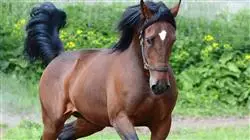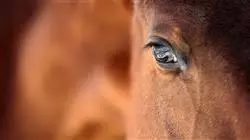University certificate
The world's largest faculty of veterinary medicine”
Introduction to the Program
Society demands veterinary professionals who are experienced in working with equines and with extensive knowledge of Functional Anatomy. Don’t think twice and study with us”

The movement of the horse is developed fundamentally in three gaits: walk, trot and canter. However, as in human sport, each equestrian discipline requires specific biomechanics and therefore has specific locomotor requirements. Understanding this, professionals can facilitate appropriate movement patterns or, on the contrary, identify possible limiters of sports performance. All this has a very important implications for the clinical interpretation of numerous pathologies of the musculoskeletal apparatus of the horse.
Consequently, this Postgraduate certificate studies the most significant aspects of Functional Anatomy and biomechanical features in the main locomotor units of the horse: thoracic limb, pelvic limb and dorsal line. On the other hand, natural movements are analyzed, as well as the technical demands of specific exercises in the disciplines of jumping and dressage, fundamentally. The possible locomotive modifications caused by the frame, type of track and sports equipment are also detailed.
In short, detailed knowledge of the Functional Anatomy of the horse facilitates the clinical recognition of multiple skeletal pathologies that must be addressed with different forms of treatment through physiotherapy and rehabilitation.
This Postgraduate certificate provides students with specialist tools and skills to enhance their professional practice, and key competencies such as knowledge of the day-to-day work of the veterinary professional, and responsibility in the monitoring and supervision of their work, as well as communication skills for effective teamwork.
In addition, as it is an online course, the student is not conditioned by fixed schedules or the need to move to another physical location, but can access the contents at any time of the day, balancing their work or personal life with their academic life.
Don't miss the opportunity to study this Postgraduate certificate in Functional Anatomy. It's the perfect opportunity to advance your career"
This Postgraduate certificate in Functional Anatomy contains the most complete and up-to-date scientific program on the market. The most important features include:
- Practical cases presented by experts in Functional Anatomy
- Graphic, schematic, and practical contents which provide scientific and practical information on the disciplines that are essential for professional practice
- Practical exercises where self-assessment can be used to improve learning
- Special emphasis on innovative methodologies in functional anatomy
- Theoretical lessons, questions to the expert, debate forums on controversial topics, and individual reflection assignments
- Content that is accessible from any fixed or portable device with an Internet connection
This Postgraduate certificate is the best investment you can make when choosing a refresher program to expand your existing knowledge of Functional Anatomy”
Its teaching staff includes veterinary professionals who contribute their expertise to this program, as well as renowned specialists from leading societies and prestigious universities.
The multimedia content, developed with the latest educational technology, will provide the professional with situated and contextual learning, i.e., a simulated environment that will provide immersive education programmed to learn in real situations.
This program is designed around Problem-Based Learning, whereby the professional must try to solve the different professional practice situations that arise throughout the program. For this purpose, the professional will be assisted by an innovative interactive video system developed by renowned and experienced experts in Functional Anatomy.
This program comes with the best educational material, providing you with a contextual approach that will facilitate your learning"

This 100% online Postgraduate Certificate will allow you to balance your studies with your professional work while increasing your knowledge in this field"
Why study at TECH?
TECH is the world’s largest online university. With an impressive catalog of more than 14,000 university programs available in 11 languages, it is positioned as a leader in employability, with a 99% job placement rate. In addition, it relies on an enormous faculty of more than 6,000 professors of the highest international renown.

Study at the world's largest online university and guarantee your professional success. The future starts at TECH”
The world’s best online university according to FORBES
The prestigious Forbes magazine, specialized in business and finance, has highlighted TECH as “the world's best online university” This is what they have recently stated in an article in their digital edition in which they echo the success story of this institution, “thanks to the academic offer it provides, the selection of its teaching staff, and an innovative learning method aimed at educating the professionals of the future”
A revolutionary study method, a cutting-edge faculty and a practical focus: the key to TECH's success.
The most complete study plans on the university scene
TECH offers the most complete study plans on the university scene, with syllabuses that cover fundamental concepts and, at the same time, the main scientific advances in their specific scientific areas. In addition, these programs are continuously being updated to guarantee students the academic vanguard and the most in-demand professional skills. In this way, the university's qualifications provide its graduates with a significant advantage to propel their careers to success.
TECH offers the most comprehensive and intensive study plans on the current university scene.
A world-class teaching staff
TECH's teaching staff is made up of more than 6,000 professors with the highest international recognition. Professors, researchers and top executives of multinational companies, including Isaiah Covington, performance coach of the Boston Celtics; Magda Romanska, principal investigator at Harvard MetaLAB; Ignacio Wistumba, chairman of the department of translational molecular pathology at MD Anderson Cancer Center; and D.W. Pine, creative director of TIME magazine, among others.
Internationally renowned experts, specialized in different branches of Health, Technology, Communication and Business, form part of the TECH faculty.
A unique learning method
TECH is the first university to use Relearning in all its programs. It is the best online learning methodology, accredited with international teaching quality certifications, provided by prestigious educational agencies. In addition, this disruptive educational model is complemented with the “Case Method”, thereby setting up a unique online teaching strategy. Innovative teaching resources are also implemented, including detailed videos, infographics and interactive summaries.
TECH combines Relearning and the Case Method in all its university programs to guarantee excellent theoretical and practical learning, studying whenever and wherever you want.
The world's largest online university
TECH is the world’s largest online university. We are the largest educational institution, with the best and widest online educational catalog, one hundred percent online and covering the vast majority of areas of knowledge. We offer a large selection of our own degrees and accredited online undergraduate and postgraduate degrees. In total, more than 14,000 university degrees, in eleven different languages, make us the largest educational largest in the world.
TECH has the world's most extensive catalog of academic and official programs, available in more than 11 languages.
Google Premier Partner
The American technology giant has awarded TECH the Google Google Premier Partner badge. This award, which is only available to 3% of the world's companies, highlights the efficient, flexible and tailored experience that this university provides to students. The recognition as a Google Premier Partner not only accredits the maximum rigor, performance and investment in TECH's digital infrastructures, but also places this university as one of the world's leading technology companies.
Google has positioned TECH in the top 3% of the world's most important technology companies by awarding it its Google Premier Partner badge.
The official online university of the NBA
TECH is the official online university of the NBA. Thanks to our agreement with the biggest league in basketball, we offer our students exclusive university programs, as well as a wide variety of educational resources focused on the business of the league and other areas of the sports industry. Each program is made up of a uniquely designed syllabus and features exceptional guest hosts: professionals with a distinguished sports background who will offer their expertise on the most relevant topics.
TECH has been selected by the NBA, the world's top basketball league, as its official online university.
The top-rated university by its students
Students have positioned TECH as the world's top-rated university on the main review websites, with a highest rating of 4.9 out of 5, obtained from more than 1,000 reviews. These results consolidate TECH as the benchmark university institution at an international level, reflecting the excellence and positive impact of its educational model.” reflecting the excellence and positive impact of its educational model.”
TECH is the world’s top-rated university by its students.
Leaders in employability
TECH has managed to become the leading university in employability. 99% of its students obtain jobs in the academic field they have studied, within one year of completing any of the university's programs. A similar number achieve immediate career enhancement. All this thanks to a study methodology that bases its effectiveness on the acquisition of practical skills, which are absolutely necessary for professional development.
99% of TECH graduates find a job within a year of completing their studies.
Postgraduate Certificate in Functional Anatomy
The study of functional anatomy is fundamental to understanding how the human body functions and how its different systems interact to maintain homeostasis and perform vital functions. It also encompasses the detailed analysis of the structure and function of the body's organs, systems and tissues. If you want to understand how these elements work to maintain homeostasis and allow the performance of essential physical and metabolic activities in daily life, you've come to the right place. At TECH Global University you will find the most complete and up-to-date Postgraduate Certificate in Functional Anatomy in the educational field. Here, we offer you from flexible classes that easily adapt to your routine, to a relearning methodology, ideal to internalize the knowledge in a more efficient and productive way. The program consists of various modules, through which you will delve into the musculoskeletal, cardiovascular, respiratory and nervous systems. You will also learn about the anatomical structure of each system, its function and relationship with the other systems of the body.
Specialize in functional anatomy
.
What is the hierarchical organization of the human body, how do the cellular and tissue levels function, the organ systems and their integration in the organism? These and other concepts you will reinforce through this very complete Postgraduate Certificate, designed by the best specialists in the sector. Through our educational scheme, you will delve into the identification and localization of anatomical structures in the human body, both on the surface and in depth, using palpation techniques, virtual dissection, medical imaging and other modern diagnostic tools. You will also understand the influence of anatomical structure in the physiological and biomechanical function of the human body, in the prevention or treatment of injuries and in diseases related to movement and physical activity. This will enable you to understand the clinical relevance of functional anatomy in the diagnosis and treatment of various health conditions.







